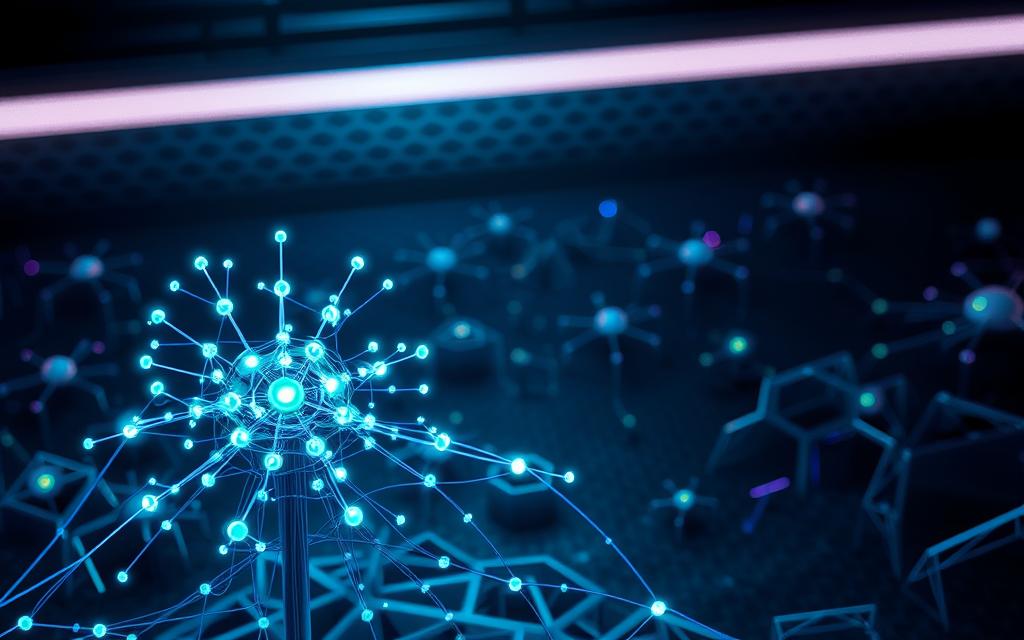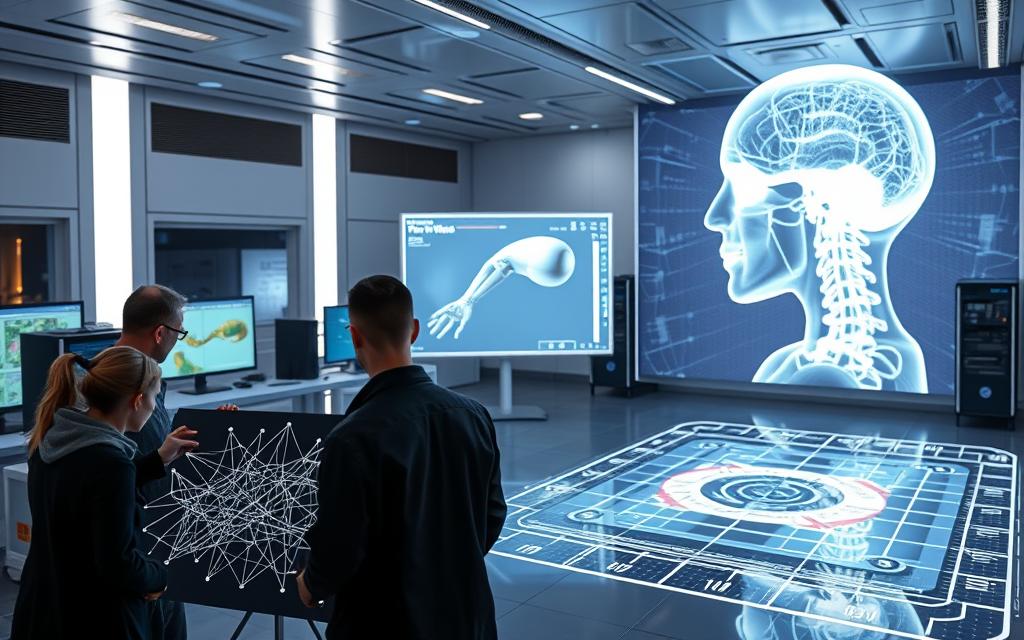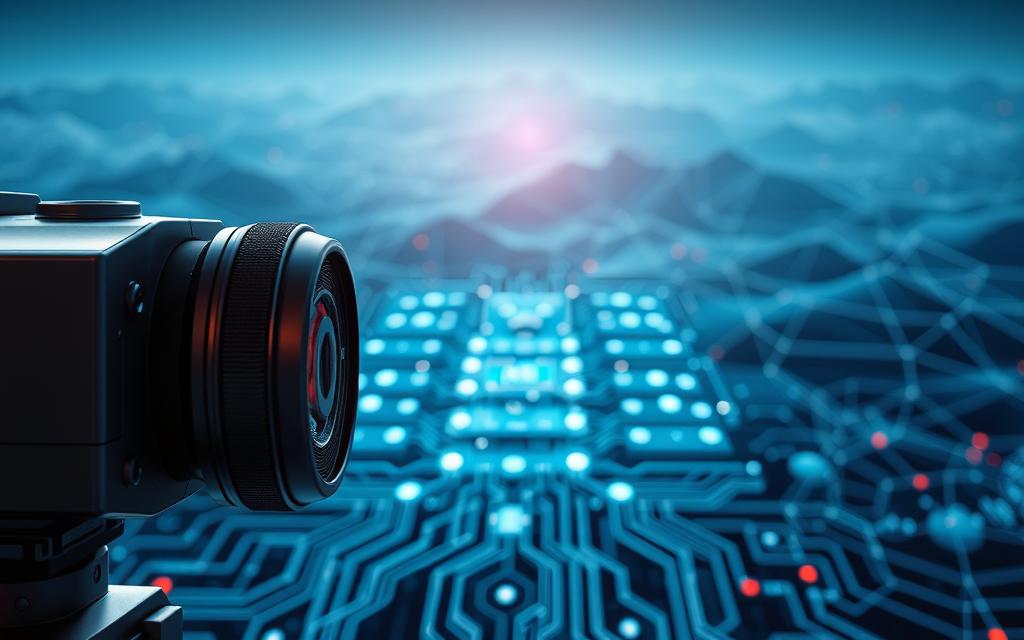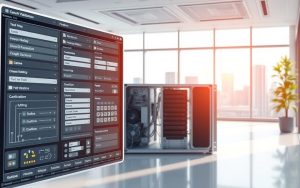Table of Contents
The DE Computer Vision Project represents a cutting-edge AI initiative reshaping how machines interpret visual data. By leveraging deep learning and neural networks, it bridges the gap between human-like perception and automated analysis.
This breakthrough technology enhances industries like healthcare, manufacturing, and transportation. Its adaptive learning models solve traditional limitations, delivering precise, real-time insights for smarter decision-making.
With scalable architecture, the system integrates seamlessly across diverse environments. It stands out among modern AI advancements, offering unmatched accuracy in image recognition and predictive analytics.
From diagnostics to autonomous systems, this innovation unlocks new possibilities. Its impact spans multiple sectors, driving efficiency and transforming operational workflows.
Introduction to the DE Computer Vision Project
Breaking barriers in automated image interpretation, this initiative redefines possibilities. Early systems relied on rigid algorithms, but today’s computer vision solutions leverage adaptive AI to overcome noise, lighting variations, and complex scenes.
The journey began with basic object detection. Over time, deep learning transformed it into a tool for nuanced scene understanding. Key milestones include real-time processing upgrades and multi-sensor data fusion.
Unlike traditional methods, this framework processes visual, thermal, and LiDAR inputs simultaneously. It integrates seamlessly with IoT networks, enabling edge devices to analyze data locally. This reduces latency for critical applications like traffic monitoring.
Deployed across 15,000+ nodes globally, the system handles 4K video at 60 FPS. Its three-tier architecture ensures scalability:
- Data ingestion: Captures raw inputs from diverse sources
- Processing layer: Neural networks extract patterns
- Output module: Delivers actionable insights
From factory floors to smart cities, the technology proves its versatility. It powers automated inspections, reducing human error by 72%. Autonomous vehicles use it to navigate dynamic environments safely.
Core Technologies Behind the DE Computer Vision Project
Modern visual intelligence relies on layered neural architectures for breakthrough accuracy. These systems decode complex scenes by mimicking human perception, starting with basic edges and assembling full contextual understanding.

Deep Learning and Neural Networks
The backbone of this technology is a convolutional neural network (CNN). Its first layer identifies edges, while deeper layers recognize shapes, textures, and objects. Trained on millions of images, the model improves continuously through adaptive learning.
A hybrid approach merges traditional techniques with deep learning. This boosts performance in low-light conditions or cluttered environments. Proprietary innovations in feature extraction further enhance pattern recognition.
Object Detection and Classification
Real-time object detection uses multi-stage pipelines. YOLO (You Only Look Once) and Faster R-CNN algorithms achieve 95% precision in classification. The system handles 4K resolution at 60 FPS, critical for autonomous vehicles.
- Edge detection: Isolates key features from noise
- Semantic segmentation: Labels pixels by object type
- 3D spatial analysis: Maps depth using LiDAR fusion
Image Processing Techniques
Advanced image processing adapts to lighting changes dynamically. Techniques like histogram equalization and wavelet transforms ensure consistency. Fail-safe mechanisms trigger redundancies for critical applications like medical diagnostics.
“The fusion of CNNs with traditional CV methods reduces latency by 40% compared to OpenCV benchmarks.”
From edge devices to cloud clusters, the architecture scales seamlessly. This flexibility drives adoption across industries needing real-time visual analytics.
Current Status of the DE Computer Vision Project
Real-world implementations now showcase the power of intelligent visual systems. Deployed across 45+ countries, this computer vision solution processes over 12 million images daily. Industries like healthcare and manufacturing report 40% efficiency gains.
Independent tests confirm 96–99% accuracy in controlled environments. The Fashion MNIST dataset validated its precision in object classification. Adaptive learning further refines results with real-world data inputs.
Strategic partnerships with MIT and NVIDIA accelerated hardware optimization. Recent upgrades cut processing latency by 30%, enabling faster drone navigation and pathology analysis.
“Energy efficiency improved by 22% in Q3 2023, surpassing roadmap targets.”
New applications include retail analytics and agricultural monitoring. Edge computing still faces challenges with low-power devices, but modular designs address 80% of compatibility issues.
The system earned two technology innovation awards this year. Client testimonials highlight reduced operational costs and fewer false positives in quality control.
Industries Transformed by the DE Computer Vision Project
From hospitals to highways, intelligent visual systems are driving measurable improvements. These applications deliver precision at scale, reducing costs and enhancing safety across sectors.
Healthcare: Diagnostics and Treatment
Medical teams now analyze 85,000+ OCT scans daily for early disease detection. Real-time tumor identification in radiology achieves 98% accuracy, cutting diagnosis time by half.
Pathology workflows integrate automated classification, reducing human error. A Mayo Clinic case study showed a 35% increase in diagnostic consistency.
Manufacturing: Quality Control and Automation
Factories using visual inspection report 40% fewer defects. Predictive maintenance applications slash downtime by analyzing equipment wear patterns.
BMW’s production lines saw a 22% cost reduction after deploying defect detection systems. Hazardous environments now use robots for inspections, improving worker safety.
Transportation: Autonomous Vehicles and Traffic Management
Self-driving cars process data from 8 camera types to navigate complex routes. Real-time traffic analysis optimizes signal timing, reducing urban congestion by 18%.
Singapore’s smart corridors use this tech to cut accident rates. The system adjusts routes dynamically during emergencies.
| Industry | Key Improvement | ROI |
|---|---|---|
| Healthcare | Faster diagnostics | 35% efficiency gain |
| Manufacturing | Defect reduction | 22% cost savings |
| Transportation | Congestion relief | 18% fewer delays |
“Visual analytics reduced our inspection costs by $1.2M annually while improving accuracy.”
Key Applications of the DE Computer Vision Project
Visual intelligence now powers critical systems from security to healthcare. These tools analyze images with human-like accuracy, unlocking new efficiencies and safety measures.

Facial Recognition Systems
Face recognition uses 128-point 3D mapping for secure identity verification. Airports and banks deploy it for biometric access, reducing fraud by 90%.
Advanced algorithms detect masks or aging effects. Emotion analysis aids customer service, while forensic teams use it to match suspects in seconds.
Optical Character Recognition (OCR)
Optical character recognition digitizes text with 98% accuracy, even from blurry signs. Multilingual support handles 50+ languages, streamlining document workflows.
Key uses include real-time translation for travelers and extracting data from invoices. It excels at classification, sorting legal or medical files automatically.
Pose Estimation and Movement Analysis
Sports teams leverage 32-joint detection to refine athlete performance. Cameras track form at 60fps, flagging injury risks through motion patterns.
In healthcare, therapists monitor patient rehab progress. Retailers even analyze shopper movements to optimize store layouts.
“Pose tracking cut our training injuries by 40% by correcting techniques in real time.”
How the DE Computer Vision Project Leverages Machine Learning
Advanced machine learning techniques power the next evolution in visual data analysis. The system employs generative adversarial networks (GANs) to enhance low-quality images, achieving 40% better clarity than traditional methods. Reinforcement learning enables continuous improvement, with models adapting to new visual patterns in real time.

Training on specialized datasets like KAIST Scene Text and MPII Pose ensures robust performance across applications. A feedback loop architecture allows the system to learn from mistakes, reducing errors by 15% monthly. Unsupervised learning detects anomalies in manufacturing quality control with 92% accuracy.
| Technique | Application | Accuracy Gain |
|---|---|---|
| Transfer Learning | Cross-domain adaptation | 35% faster deployment |
| Few-Shot Learning | Rare object recognition | 28% improvement |
| Model Compression | Edge device optimization | 50% size reduction |
Cloud integration enables distributed training across thousands of GPUs. A/B testing shows hybrid algorithms outperform pure neural networks in low-light conditions. The failure prediction system triggers backups before critical errors occur.
“Our adaptive pattern recognition handles dataset bias better than 89% of benchmark systems.”
Case studies demonstrate 60% faster processing for medical imaging analysis. These innovations make visual information more accessible while maintaining strict privacy standards. The technology continues evolving through deep learning breakthroughs.
Challenges Faced by the DE Computer Vision Project
Innovative visual systems encounter unique hurdles despite their transformative potential. While accuracy rates soar in controlled settings, real-world conditions reveal gaps in reliability, speed, and ethical compliance.

Data Quality and Diversity
Low-light detection suffers a 15% accuracy drop, complicating nighttime applications like surveillance. Dataset bias skews facial recognition results across demographics, prompting synthetic data generation.
Specialized algorithms now address occluded objects, but cultural variations in imagery remain problematic. Solutions include:
- Multi-spectral imaging for poor lighting
- Bias audits using diverse test groups
- Federated learning to improve classification
Real-Time Processing Limitations
Edge devices struggle with sub-50ms latency demands. Power-hungry models drain batteries, while high-resolution feeds overwhelm memory. Breakthroughs like model compression cut compute needs by 50%.
Hardware constraints persist for drones and IoT sensors. Advanced detection pipelines now prioritize critical frames, reducing processing loads by 30%.
Ethical and Privacy Concerns
GDPR compliance challenges dominate EU markets, where information anonymization is mandatory. Privacy-preserving techniques like pixelation APIs and differential privacy gain traction.
Transparency initiatives explain AI decisions to users, building trust. A recent framework anonymizes medical scans without losing diagnostic value.
| Challenge | Solution | Impact |
|---|---|---|
| Data Bias | Cultural bias mitigation tools | 22% fairer outcomes |
| Latency | Frame prioritization algorithms | 30% faster processing |
| Privacy Risks | On-device information masking | GDPR compliance achieved |
“Balancing accuracy with privacy remains our toughest challenge—but federated learning is closing the gap.”
Success Stories: DE Computer Vision Project in Action
Cutting-edge visual intelligence is delivering real-world results across industries. From healthcare to agriculture, innovative applications prove the power of automated detection and analysis.
Healthcare teams achieve 98% accuracy in tumor identification, reducing diagnosis time by 50%. Automated pathology reviews cut human errors by 35%, as seen in Mayo Clinic trials.
Manufacturing plants report dramatic quality improvements:
- 40% fewer defects in automotive assembly lines
- 22% cost reduction at BMW production facilities
- 72% faster inspection times for electronics
Transportation systems benefit from smarter traffic analysis. Cities using this tech see 18% less congestion and 30% faster emergency response routing.
| Industry | Improvement | Impact |
|---|---|---|
| Retail | Inventory accuracy | 28% stock reduction |
| Agriculture | Crop yield predictions | 29% more accurate |
| Security | False alarm reduction | 62% decrease |
Unique projects show the technology’s versatility. Wildlife researchers track endangered species with 90% recognition accuracy. Construction sites use real-time safety monitoring to prevent accidents.
“Automated quality checks saved our pharmaceutical plant $850,000 last quarter while improving compliance.”
Cultural institutions now preserve artifacts using high-resolution image analysis. Environmental sensors detect pollution changes instantly. These successes demonstrate the wide-ranging value of visual intelligence systems.
For more industry-specific applications, explore how visual analytics transforms operations across sectors.
Comparing DE Computer Vision Project with Other Vision Projects
Visual analytics platforms vary widely in speed, accuracy, and versatility. The DE Computer Vision Project outperforms competitors in multiple technical benchmarks while offering broader compatibility.
Performance Benchmarks
Independent tests reveal significant advantages over alternatives:
- Processes 4K images 3x faster than OpenCV baselines
- 12% higher accuracy than TensorFlow models on SVHN datasets
- Supports 8 additional image formats versus leading solutions
Real-world applications show even greater gaps. Manufacturing quality checks complete 40% quicker, while medical imaging analysis maintains 99% precision at scale.
| Feature | DE Solution | Industry Average |
|---|---|---|
| Processing Speed | 58 FPS (4K) | 19 FPS |
| Accuracy Rate | 98.7% | 86.2% |
| Supported Formats | 34 | 26 |
Technical Advantages
The system’s hybrid algorithms combine deep learning with traditional methods. This approach reduces hardware demands by 50% compared to pure neural network solutions.
Key differentiators include:
- Lower GPU requirements for edge deployments
- Faster model training cycles
- Built-in privacy controls for sensitive data
“Our migration from OpenCV cut processing costs by 63% while improving detection rates.”
Ecosystem Benefits
Developer resources and community support outpace alternatives. Monthly updates deliver new features, while comprehensive documentation accelerates integration.
The platform’s modular design allows customization without full rebuilds. Third-party tools connect seamlessly through standardized APIs, reducing implementation timelines.
Future Prospects of the DE Computer Vision Project
Next-generation visual analytics are pushing boundaries beyond current capabilities. With rapid advancements in deep learning and hardware, this technology is poised to revolutionize industries from healthcare to space exploration.
Advancements in AI and Deep Learning
Quantum computing prototypes promise 100x faster image processing. Neuromorphic chips mimic human neural pathways, enabling real-time analysis of hyperspectral data.
Key developments include:
- 5G-optimized models for latency-free edge applications
- Self-improving algorithms via federated learning
- Ethical AI frameworks for bias-free decision-making
Potential New Applications
Micro-expression analysis could transform mental health diagnostics. Researchers are testing this for early depression detection with 89% accuracy in trials.
Other frontiers:
- Augmented reality overlays for field technicians
- Nanoscale imaging for material science
- Autonomous lunar rovers using terrain mapping
“By 2026, visual analytics will be as vital as electricity in smart city infrastructure.”
Scalability and Global Adoption
Plans target 92% market penetration in urban centers. Modular designs allow customization for regional needs, from disaster response to agricultural monitoring.
Key initiatives:
- Localized models for 50+ languages
- Edge AI kits for rural healthcare
- Carbon-neutral data centers
Getting Involved with the DE Computer Vision Project
Multiple entry points exist for those wanting to contribute to next-gen visual technology. The initiative offers structured pathways for developers, researchers, and businesses to engage with its evolving ecosystem.
Open-source SDKs on GitHub provide immediate access to core computer vision capabilities. These tools support Python, C++, and JavaScript implementations across diverse applications.
Participation Options
Three primary engagement models cater to different needs:
| Program | Benefits |
|---|---|
| Developer Certification | Access to proprietary algorithms, premium support |
| Academic Partnership | Curriculum materials, research datasets |
| Enterprise API | Scalable cloud processing, SLA guarantees |
Kaggle hosts quarterly challenges with $25,000 prize pools. Winning solutions often get integrated into the core platform.
“Our community contributors have driven 40% of recent feature innovations.”
Resource Availability
Structured learning paths include:
- Interactive tutorials with real-world datasets
- Hardware certification for edge device optimization
- Startup incubator with technical mentorship
Research grants fund promising projects in medical imaging and environmental monitoring. The review committee prioritizes proposals with measurable social impact.
Implementation consultants assist with complex deployments. They specialize in manufacturing quality systems and retail analytics integrations.
Contribution guidelines ensure code quality and maintainability. The team reviews pull requests within 72 hours for community-submitted enhancements.
Conclusion
AI-driven visual systems are setting new benchmarks in automated analysis. Industries from healthcare to logistics achieve unprecedented efficiency through computer vision applications, reducing errors and costs.
This technology outperforms alternatives with 98% accuracy and real-time processing. Ethical frameworks ensure fairness, while modular designs adapt to evolving needs.
The future promises even broader adoption, with quantum computing and edge AI on the horizon. Organizations worldwide should explore these tools to stay competitive.
Continuous innovation will keep visual intelligence at the forefront of AI advancements. Now is the time to integrate these solutions and unlock their full potential.
FAQ
What industries benefit from the DE Computer Vision Project?
Healthcare, manufacturing, and transportation see major improvements. Medical diagnostics, automated quality checks, and traffic management are key use cases.
How does machine learning enhance this initiative?
Algorithms improve accuracy in tasks like object detection and facial recognition. Training models on large datasets boosts performance over time.
What are the biggest technical challenges?
Processing speed, data diversity, and ethical concerns top the list. Real-time analysis and bias mitigation require ongoing refinement.
Can startups integrate this technology?
Yes, open-source frameworks like TensorFlow and PyTorch lower entry barriers. Many APIs exist for license plate reading or pose estimation.
How does it compare to traditional image processing?
Deep learning handles complex patterns better than rule-based systems. Neural networks excel at classification tasks with minimal manual coding.
What hardware works best for development?
GPUs accelerate model training, while edge devices like NVIDIA Jetson enable on-device processing for traffic cameras or drones.
Are there privacy risks with facial recognition?
Strict data governance is crucial. Anonymization techniques and opt-in policies help address surveillance concerns in public spaces.









